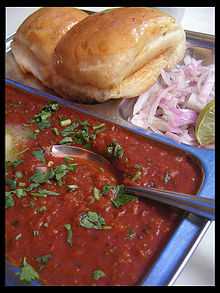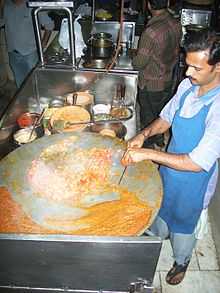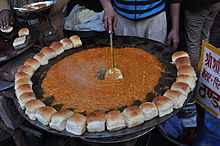Pav Bhaji
| Pav Bhaji | |
|---|---|
 Pav Bhaji | |
| Alternative names | Bhaji-pav |
| Course | Snack |
| Place of origin |
|
| Region or state | Maharashtra |
| Main ingredients | Pav, potatoes, tomatoes, onions, mixed vegetables |
|
| |
Pav bhaji (Marathi: पाव भाजी) is an Indian fast food dish that originated as Maharashtrian cuisine. While Bhaji is a traditional Marathi name for a vegetable dish, the Pav or Pau or Pao was the Portuguese word for bread (small rolls) introduced by them during their brief presence in Maharashtra, before it was gifted by them to the English as part of the dowry for Catherine of Braganza's marriage to Charles II. The pav-bhaji is a spicy preparation with a mixture of vegetables, either whole or mashed, a generous dose of fresh tomatoes, a dollop of butter, optional toppings of cheese and dry-fruits and fresh fruits, consumed with warm bread gently or crispy fried in butter - an all-time, any-time favourite with Mumbaikars. It is native to Maharashtra and has now become popular in most metropolitan areas in India, especially in those of central and western Indian states[1] such as Gujarat and Karnataka.[2] Pav means bread. Bhaji in Marathi means vegetable dish. Pav bhaji consists of bhaji (a thick potato-based curry) garnished with coriander, chopped onion, and a dash of lemon and lightly toasted pav. The pav is usually buttered on all sides.
History
The origin of this dish is traced to textile mill workers in Mumbai[3] in the 1850s.[4]
The mill workers used to have lunch breaks too short for a full meal, and a light lunch was preferred to a heavy one, as the employees had to return to strenuous physical labor after lunch. A vendor created this dish using items or parts of other dishes available on the menu. Roti or rice was replaced with pav and the curries that usually go with Indian bread or rice were amalgamated into just one spicy concoction, the 'bhaji'. Initially, it remained the food of the mill-workers. With time the dish found its way into restaurants and spread over Central Mumbai and other parts of the city via the Udupi restaurants.[4][5]
Such is the popularity of this dish, that it is common to find it on the menu of most Indian restaurants serving fast food in Asia (especially Singapore, Hong Kong), America, UK (London), Switzerland and elsewhere.[6] It has also come to become the staple dish in many Indian diets, due to its simplicity and delicacy.
Preparation


The recipe for Pav Bhaji varies greatly as it is essentially a fast food dish to be prepared quickly. The general procedure for making the bhaji remains the same. Potatoes are mashed on a flat griddle (tava), and made into a thick gravy after adding diced tomatoes, finely chopped onion, green peas and chopped capsicum (green bell pepper). Other assorted vegetables such as cauliflower, cabbage, carrots are mashed and added. Boiled toor dal or masoor dal may also be mashed in with the potato base to maintain the texture of the bhaji. Garlic too is added at times to spice it up. A special blend of spices simply called the pav bhaji masala[7] is added to this thick gravy giving pav bhaji its authentic slightly orange brown color. The gravy is then allowed to simmer on the pan for a few minutes and is served hot in a flat dish with a tablespoon of butter on top.
The pav is heated on the griddle and buttered generously. The Bhaji is garnished with coriander and diced onions.
In restaurants some more varieties are available including;
- Cheese Pav Bhaji, in which the bhaji had an additional garnishing of cheese
- Paneer Pav Bhaji, prepared with paneer (cottage cheese) as one of the ingredients in the bhaji along with the vegetables.
- Mushroom Pav Bhaji, with mushrooms as one of the ingredients in the bhaji along with the vegetables.
- Khada Pav Bhaji, ('खडा'). Vegetables are not mashed, but small pieces cooked with masala gravy.
- Jain Pav Bhaji, replacing the potatoes with plantain, as the Jains do not eat potatoes. Onion and garlic is not added either.
- Kolhapuri Pav Bhaji with extra spice.
- Kathyawadi Pav Bhaji with buttermilk, eaten particularly in the Kathiyawad.
- Dryfruit Pav Bhaji with added dry fruits.
Versatility
It can be eaten as a snack or as a meal in itself. It is often eaten as an evening snack between lunch and dinner, particularly in western India. In this part, Pav bhaji is available on hand carts and at kiosks. It is also available in hotels and eateries serving fast food. In recent years, Pav bhaji is also consumed as a light evening meal, and is also a party favorite.
Now Pav Bhaji pulao is also making an appearance on the streets of Mumbai.
See also
References
- ↑ Sidhpuria. Retailing Franchising. Tata McGraw-Hill Education . ISBN 978-0-07-014503-0 . pp. 137
- ↑ Mumbai pav bhaji making waves in kebab land Indian Express, 15 April 2007.
- ↑ Michael Patrao. "Taking pride in our very own pav". Deccan Herald.
- ↑ 4.0 4.1 "What Mumbaikars owe to the American Civil War: ‘pav bhaji’". Mint (newspaper). 4 August 2011.
- ↑ Rushina Munshaw-Ghildiyal (18 July 2011). "A feast of flavours". Hindustan Times.
- ↑ Pathak, Anil (May 20, 2003). "'Bhaji pav' to invade NY's Times Square". India Times. Retrieved 2013-06-20.
- ↑ Williams, James. "Pav Bhaji Masala". recipickr.com. ReciPickr. Retrieved 11 September 2014.


